Regular readers know that I occasionally recycle older posts because most current blog followers have never seen them. In a recent email conversation with Patty Chadwick she suggested that it might be fun for readers to see my very first Feathered Photography blog post. Well, this is it – originally published on August 18, 2010. I’ve rewritten some of the text and many will notice that the images are smaller than usual – 720 pixels on the long side instead of 900. That’s just the size I used to post them back then…
Shrikes are called “butcher birds” for good reason. They regularly impale their prey (larger insects, small rodents, reptiles or birds) on thorns, barbed wire or other sharp projections and they do it for several reasons. It helps them to tear flesh into bite sized pieces, they use it as a method of caching (storing) their food and it helps them to survive eating the toxic lubber grasshopper because the toxins within the insect degrade to harmless substances after being stored for a couple of days.
I had never seen or photographed this behavior, or evidence of it, until this summer when I did both several times.
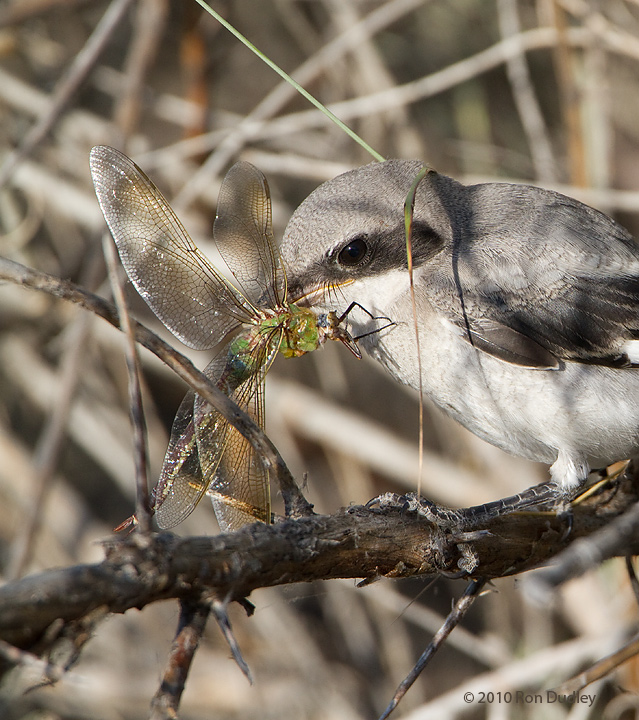
This juvenile Loggerhead Shrike is preparing to impale a dragonfly on one of several thorns we can see. I believe this young bird was practicing the behavior partly because it seemed to have some difficulty with the impaling process. Here the shrike appears to be trying to decide which thorn to use for its grisly task. Eventually the thorn just behind the lower wings of the dragonfly was chosen.
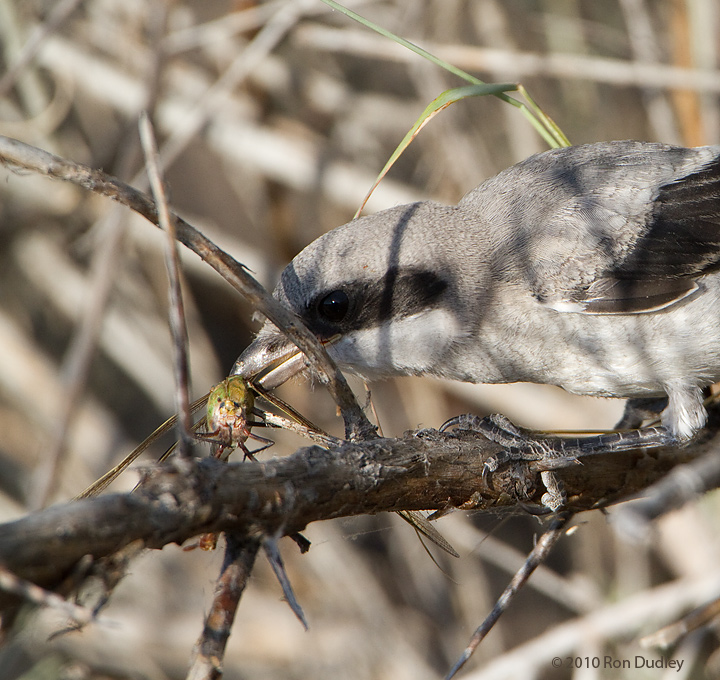
Here the shrike is in the process of impaling the dragonfly by puncturing its body with the end of the sharp thorn and then pulling the insect down its length. The young bird was tentative and clumsy as it practiced the behavior…
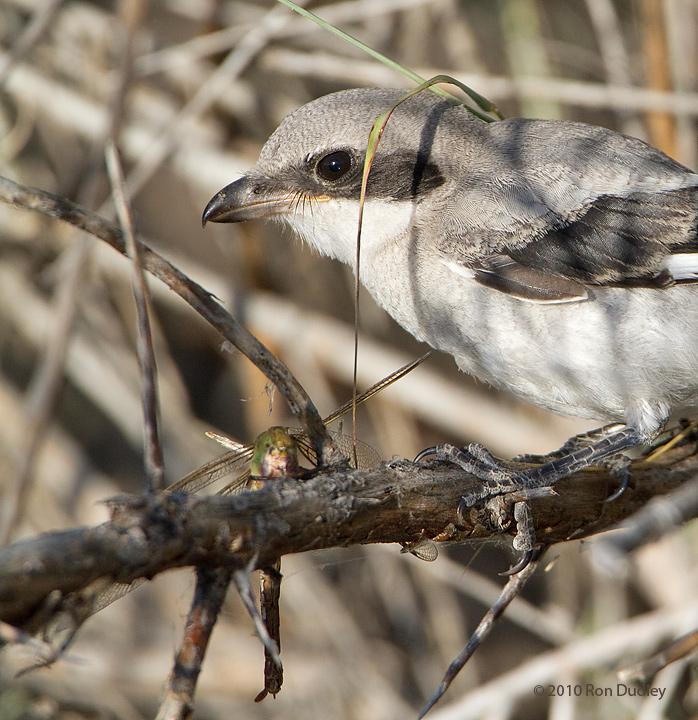
but it eventually got the job done. The insect isn’t impaled dead-center but it isn’t going anywhere either. The shrike seemed to inspect its work for a few moments…
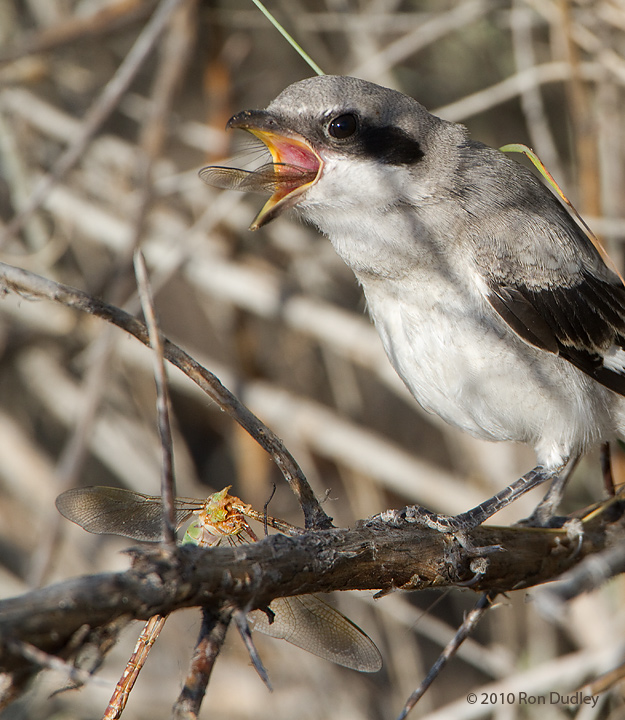
and then tore off a chunk, including wings, and gobbled it down. Here we can see that the thorn actually did impale the prey. Soon after this shot was taken the shrike removed what was left of the dragonfly from the thorn, flew with it to a different perch and then swallowed the rest of its meal.
Raptors use their powerful talons to hold their prey down while they tear pieces off to swallow but shrikes don’t have talons so impaling their larger prey before ripping off chunks is a functional alternative.
Shrikes also kill and eat small rodents. Several times recently I observed them attempting to catch voles (small rodents resembling mice). Shrikes are often referred to as “wannabe raptors” and they have some raptor adaptations including a tomial tooth (falcon tooth) on their beak that allows them to sever the spinal cord of prey. They also have the ability to carry their own weight in flight but their lack of talons makes tearing a small rodent apart very difficult.
So they often impale voles on sharp projections (or wedge them between branches) to give them the leverage needed to tear them apart. The images below are of poor quality but they do document the behavior.
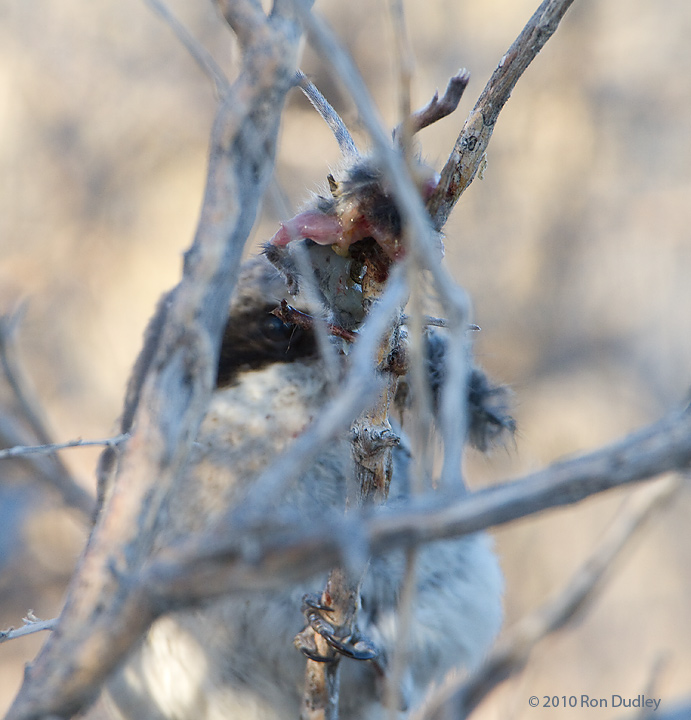
This adult Loggerhead Shrike had previously impaled or cached a vole in a dense thicket of branches. The bird was in shade and because of all the foreground twigs I had great difficulty focusing on the bird but we can see its eye within the black eye-stripe and its toes grasping the branch at bottom. The bird has torn off a furry piece of the vole which is in its beak to the right. What’s left of the vole is up top, including one foot sticking up.
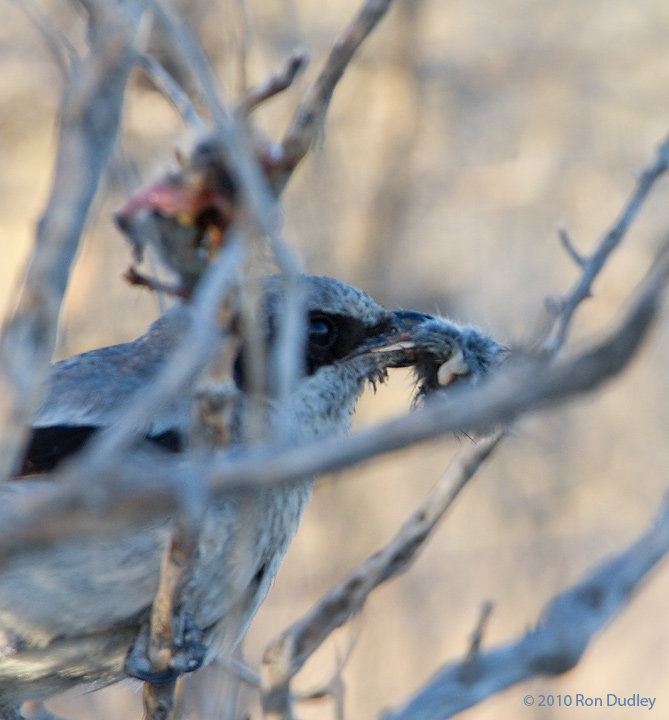
The shrike had returned to tear off a snack and here we see that chunk of vole in its beak and the rest of the blurry rodent at upper left.
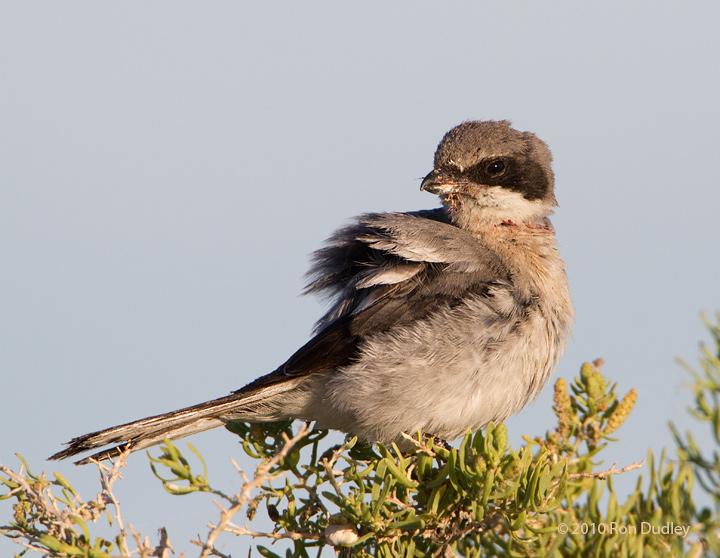
Eating rodent prey in this condition is a messy job and it usually shows. This is the same bird after it finished eating and flew to a more exposed perch. It almost looks like there was as much vole left on its face as it was able to swallow.
This photo invariably brings back a memory for me – of my daughter Shannon eating her first bowl of spaghetti with her fingers while sitting in her high chair as a very young child.
It makes me smile.
Ron


Ron you are amazing field biologist . I read about this behaviour. but i have never seen anybody capturing it so vividly . Kudos..
Ron you are an amazing field biologist . I read about this behaviour. but i have never seen anybody capturing it so vividly . Kudos..
thanks so much for reposting this most interesting piece. Isn’t nature wonderful
It is, Gillycat. It certainly is.
My gosh – your blog started off awesome — the story, the image sharpness, and the composition. Thanks for sharing!
Thanks very much, Kent.
Thank you.
I can think of a few individuals I would like to impale, though I wouldnt go back to feed on them.
I am so often awed at the survival adaptations which birds and animals adopt.
“I can think of a few individuals I would like to impale, though I wouldnt go back to feed on them.”
Hmmm, that brings a visual to mind of someone I wouldn’t be heartbroken to see impaled on a sharp stick. Perhaps (only perhaps) not in reality but I do enjoy the visual.
Boy, I really enjoyed this post because we saw a Loggerhead recently! I’ve seen them devouring a lizard while perched on a Saguaro.
Linda, If you keep your eyes peeled for it I’ll bet you could eventually find shrike prey impaled on cactus spines.
Fascinating behavioral adaptation! And so cool to see your first post. I have no problem with the reruns — recycling is very good for nature (photography). Ba-dum-tiss.
Made me smile, Marty. Thanks for that.
When I first moved to my current home 30 years ago, I noticed bits of rodent, grasshopper and even part of a small snake skewered on the thorns of one of the Honey Locust tress in the gully (Miller Park) behind my house. I did not know about shrikes at the time but started to research it and discovered it must be a shrike decorating the tree. I did not ever see a bird with the cache but would see added bits for about a month, and then it was gone and I have not seen any since.
April, I haven’t seen a lot of shrike caches over the years (probably fewer than a dozen) but I thing they’re pretty unmistakable when I do see them.
Once again you have proven your work is timeless! Great stuff, Ron! My goal this year is to find a strand of barbed wire similar to one of my boyhood favorites which literally had an impaled insect on every barb along the top wire.
Wow, that wire must have been amazing to see, Wally!
we name it “Picanço Real”.
A bit “gory” for my taste but a very interesting behavior.
Thank you for showing it.
And thank you Patty for the suggestion.
“Picanço Real”
I looked it up, Jorge. Your Portuguese name for the Loggerhead Shrike translates to “Royal Shrike”. Interesting.
So, what we really have at the end is a photo of a Shrike which has just eaten spaghetti?… A big thank you to Patty for suggesting you do this post. And as usual I learned something new – didn’t realize that those gorgeous Lubber grasshoppers had toxins (we have two varieties of those in our area, though one went completely missing this year). I am amazed that a Shrike would go after a vole, given that the vole is about as big as a Shrike.
“I am amazed that a Shrike would go after a vole, given that the vole is about as big as a Shrike.”
They’re one of the few songbirds that go after prey as large as small rodents, Susan. Ferocious little birds…
Great series! Aside from its funniness, that last photo is a really great one. It shows the proudness of the shrike (and the messiness of nature), and is a little lonely. Maybe it’s odd to say that about a photo of a bird whose face is covered in its food, but it’s just how I see it…
P.S. What size are loggerhead shrikes? I’ve never seen one, but for some reason I always imagined them as small…
Thanks, Levi. They’re about midway in size between a House Sparrow and a European Starling.
Great photos, Ron! I hadn’t seen them before so they were new to me. I’ve heard of this behaviour, but have not had an opportunity to observe it yet, so I was delighted to see your post. Thanks for the interesting information – I read about the caching of monarch butterflies degrading their toxins but not about lubber grasshoppers.
Myriam, Yes, monarch butterflies are another toxic insect they impale so that over time their poison degrades before they consume it. They do the same with toxic Eastern Narrow-mouthed Toads for the same reason.
Super photos! I’ve never seen such a thing. Lately I haven’t seen a Shrike!
Sadly, I don’t see as many as I used to either, Judy.
I don’t know what to believe anymore…my own eyes or “alternative facts”…it’s all so confusing!!!
Believe me there are no alternative facts here…
Good stuff Ron, thank you for sharing and explaining. What a great way to start off a lazy Sunday
I’m glad it started your day off well, Zaphir. Thanks.
I have known Shrikes behave this way, but have never witnessed their behavior nor have I seen a cache. This has been very educational and as a reader and fan for only several years I am very thankful to you and Patty for bringing past lessons to light. Much enjoyed this series.
Many thanks for sharing.
I’m happy to know you appreciate the occasional “rerun”, Dick. I wondered if some folks might think I was just being lazy but it’s actually almost as much work to recycle an older post as it is to start from scratch. And besides, there’s good stuff in some of those older posts that most present readers have never seen. Thank you.
Good stuff Ron. Cringe worthy behavior but very effective for the predator. I posted an entire album on Flikr last year titled “Birds behind Sticks” because I had so many great photos with a stick, or sticks, right across the bird’s face. Makes me feel better that it happens to you too!
Porcupine
Ha, it happens to me consistently, Porcupine. With birds it comes with the territory…
I’m sure glad you explained what was going on in the first photo of the adult behind branches. I don’t think I could have seen what was there without your description.
Fantastic series of shots – even way back then.
Yeah, that first photo of the adult is pretty hard to figure out without explanation, Pam. But once it’s explained I think it documents the behavior well enough. Thank you.
Wonderful documentation and wonderful memories for you, Ron. I know they clear out the bird feeders when they show up! Yesterday uplifting after the downer of the day before.
Yesterday uplifting after the downer of the day before. 
Judy, I’ve yet to see a shrike with a bird as prey but I know they do occasionally prey on them.
Great behavioral series Ron!
Charlotte
Thanks, Charlotte.